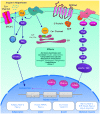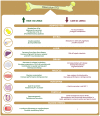Osteocalcin‑GPRC6A: An update of its clinical and biological multi‑organic interactions (Review)
- PMID: 30431093
- PMCID: PMC6297736
- DOI: 10.3892/mmr.2018.9627
Osteocalcin‑GPRC6A: An update of its clinical and biological multi‑organic interactions (Review)
Abstract
Osteocalcin is no longer regarded as a molecule exclusive to bone remodeling and osteogenesis, but as a hormone with manifold functions. The discovery of the interaction of osteocalcin with the G protein‑coupled receptor family C group 6‑member A (GPRC6A) receptor has accompanied the characterization of several roles that this peptide serves in body regulation and homeostasis. These roles include the modulation of memory in the brain, fertility in the testis, fat accumulation in the liver, incretins release in the intestine and adaptation to exercise in muscle, in addition to the well‑known effects on β‑cell proliferation, insulin release and adiponectin secretion. The aim of the present review was to provide a practical update of the multi‑organ effects that osteocalcin exerts through its interaction with GPRC6A and the clinical implications of this.
Keywords: osteocalcin; GPRC6A; glycaemia; diabetes; brain; vascular; liver; muscle; testis; intestine.
Figures


Similar articles
-
Explaining Divergent Observations Regarding Osteocalcin/GPRC6A Endocrine Signaling.Endocrinology. 2021 Apr 1;162(4):bqab011. doi: 10.1210/endocr/bqab011. Endocrinology. 2021. PMID: 33474566 Free PMC article. Review.
-
Osteocalcin: A Protein Hormone Connecting Metabolism, Bone and Testis Function.Protein Pept Lett. 2020;27(12):1268-1275. doi: 10.2174/0929866527666200505220459. Protein Pept Lett. 2020. PMID: 32370705
-
Undercarboxylated Osteocalcin: Experimental and Human Evidence for a Role in Glucose Homeostasis and Muscle Regulation of Insulin Sensitivity.Nutrients. 2018 Jun 29;10(7):847. doi: 10.3390/nu10070847. Nutrients. 2018. PMID: 29966260 Free PMC article. Review.
-
Osteocalcin, a bone-derived hormone with important andrological implications.Andrology. 2017 Jul;5(4):664-670. doi: 10.1111/andr.12359. Epub 2017 Apr 10. Andrology. 2017. PMID: 28395130 Review.
-
Evidence for Osteocalcin Binding and Activation of GPRC6A in β-Cells.Endocrinology. 2016 May;157(5):1866-80. doi: 10.1210/en.2015-2010. Epub 2016 Mar 23. Endocrinology. 2016. PMID: 27007074 Free PMC article.
Cited by
-
The link between bone-derived factors osteocalcin, fibroblast growth factor 23, sclerostin, lipocalin 2 and tumor bone metastasis.Front Endocrinol (Lausanne). 2023 Feb 28;14:1113547. doi: 10.3389/fendo.2023.1113547. eCollection 2023. Front Endocrinol (Lausanne). 2023. PMID: 36926025 Free PMC article. Review.
-
Aerobic Physical Exercise as a Non-medical Intervention for Brain Dysfunction: State of the Art and Beyond.Front Neurol. 2022 May 13;13:862078. doi: 10.3389/fneur.2022.862078. eCollection 2022. Front Neurol. 2022. PMID: 35645958 Free PMC article. Review.
-
Crosstalk of Brain and Bone-Clinical Observations and Their Molecular Bases.Int J Mol Sci. 2020 Jul 13;21(14):4946. doi: 10.3390/ijms21144946. Int J Mol Sci. 2020. PMID: 32668736 Free PMC article. Review.
-
Osteocalcin serum concentrations and markers of energetic metabolism in pediatric patients. Systematic review and metanalysis.Front Pediatr. 2023 Jan 12;10:1075738. doi: 10.3389/fped.2022.1075738. eCollection 2022. Front Pediatr. 2023. PMID: 36714656 Free PMC article. Review.
-
Current knowledge of bone-derived factor osteocalcin: its role in the management and treatment of diabetes mellitus, osteoporosis, osteopetrosis and inflammatory joint diseases.J Mol Med (Berl). 2024 Apr;102(4):435-452. doi: 10.1007/s00109-024-02418-8. Epub 2024 Feb 16. J Mol Med (Berl). 2024. PMID: 38363329 Free PMC article. Review.
References
-
- Moore KL, Dalley AF. Clinically oriented anatomy. Lipp Williams Wilkins. 2013
-
- Villafán-Bernal JR, Sánchez-Enríquez S, Muñoz-Valle JF. Molecular modulation of osteocalcin and its relevance in diabetes (Review) Int J Mol Med. 2011;28:283–293. - PubMed
-
- Hernández-Gil IFT, Gracia MAA, Pingarrón MDC, Jerez LB. Bases fisiológicas de la regeneración ósea I. Histología y fisiología del tejido óseo. Med Oral Patol Oral Cir Bucal. 2006;11:47–51.
Publication types
MeSH terms
Substances
LinkOut - more resources
Full Text Sources

